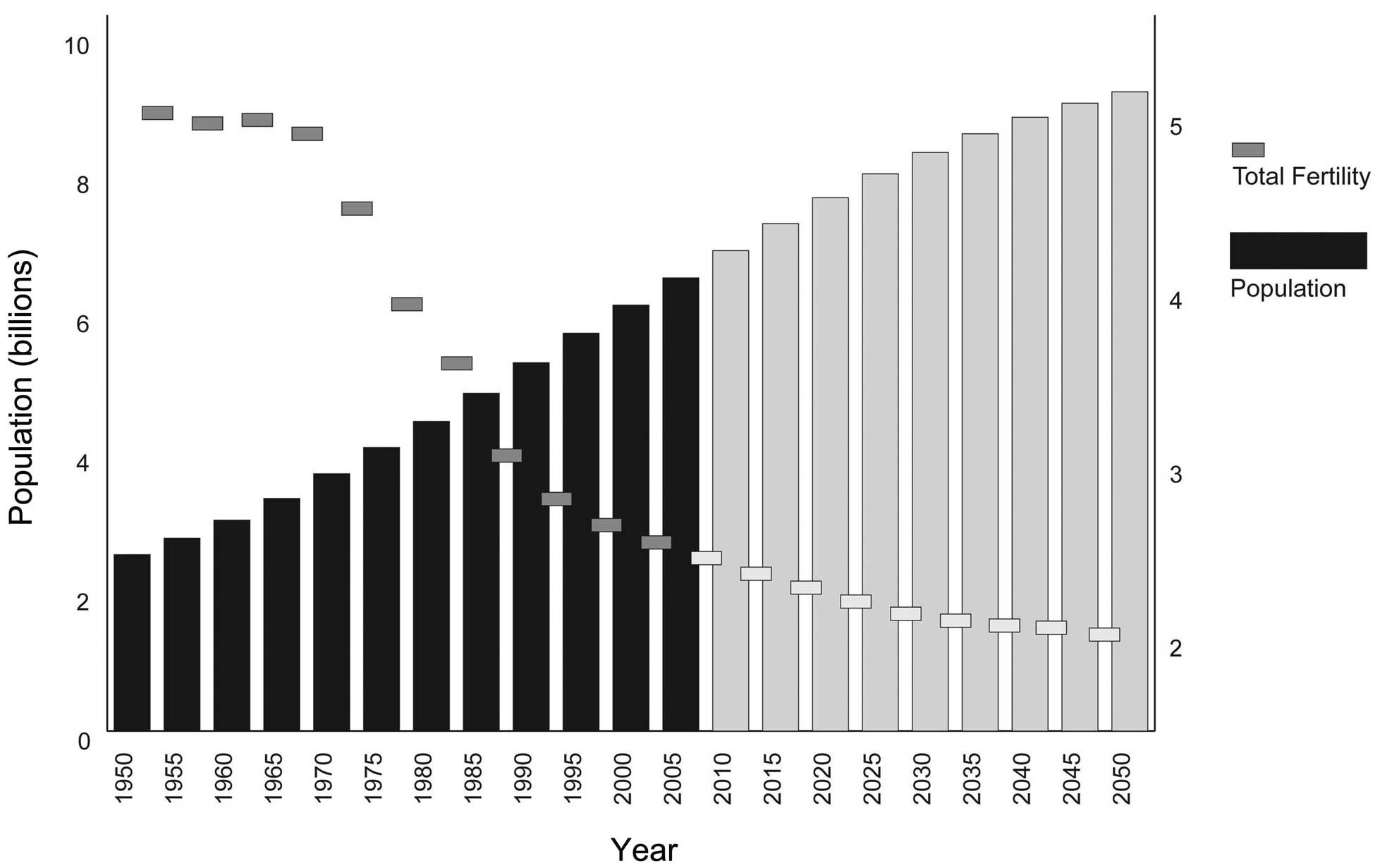accumulanatural ecosystems into agriculturally used and managed land has accelerated, which coincides with the time when formal AKST began to have a significant impact. The world population grew from about 2.5 billion people in 1950 to 6.5 billion in 2005, i.e., by a factor of 2.6; in most countries, growth rates have just recently begun to decrease. Trends indicate that the global population will reach between 7.5 and 11 billion people by 2050, depending on the expected average number of children per women (Figure 1-1).
World agricultural output, or more specifically, food output as measured in cereal and meat production, in turn, increased even more during the same period, due to large increases in fertilizer use, herbicides, plant and animal breeding, and extension of irrigated area (Figure 1-2). The total cultivated area increased much less, i.e., from 1.4 to 1.5 million ha between 1950 and 2005 (Wood et al., 2000, based on FAO data), although fallow systems were greatly reduced.
For similar figures indicating equally moderate growth of crop area see also the Millennium Ecosystem Assessment (MA, 2005a). However, more land was converted to cropland in the 30 years after 1950 than in the 150 years between 1700 and 1850 (MA, 2005a). More than half of all the synthetic nitrogen fertilizer ever applied on the planet has been used since 1985, and phosphorus use tripled between 1960 and 1990 (MA, 2005b). Globally, agricultural output has been growing at about 2% per year since 1960, with higher rates in developing countries because area productivity, particularly in sub-Saharan Africa and Latin America, is still much lower than in industrialized countries and in Asia (FAO, 2006a). Along with an increase in agricultural output, water use in agriculture has increased to 7,130 cubic kilometers today and is expected to double by 2050 (CA, 2007). Another form of competition has recently been observed between the use of crops for food and feed and the use of the same crops (e.g., maize) for biofuels; moreover, a competition at the world level is rising for the supply of protein-rich animal feeds.
Today's land use patterns in general reveal the importance of agriculture as a major land management system transforming and making use of natural ecosystems. Given a global land surface (without Antarctica) of 13,430 million ha (FAOSTAT, 2006), there are still about 30% forest ecosystems (nearly 4,000 million ha), part of which are the least converted in a biological sense. About a further 26% (3,400 million ha) are pastureland (FAOSTAT, 2006), of which about half was converted from natural grassland and the rest from forestland or woodland. About 11.5% are cropland (1,500 million ha) (FAOSTAT, 2006), most of which was also converted from forestland. The remaining share of the global land surface are deserts, shrubland and tundra (about 25%), inland water surfaces and wetlands (about 4%), and built up land for human settlements and other infrastructure (about 5%). In sum, more than half of the earth's land surface is intensively used for agricultural purposes such as cultivation, grazing, plantation forestry and aquaculture; and since 1950 one third of the soil has been profoundly altered from its natural ecosystem state because of moderate to severe soil degradation (Oldeman et al., 1990).

Figure 1-1. Total world population 1950-2050 and average number
of children per woman (total fertility). Source: UNFPA, 2007
Multifunctionality of agriculture. As an activity, agriculture has multiple outputs and contributes to several ends at the same time (Abler, 2004). Agricultural resource management thus involves more than maintaining production systems. Services such as mitigating climate change, regulating water, controlling erosion and support services such as soil formation, providing habitats for wildlife, as well as contributions to cultural activities such as use and preservation of landscapes and spiritual sites are some of the positive functions that agriculture provides. The OECD identifies two key elements of multifunctionality: externalities and jointness (OECD, 2005). Agriculture uses public goods-natural resources (landscapes, plants, animals, soils, minerals, water and atmospheric N and C) for the production of public services, common goods, and private goods (food, feed, fiber, fuel). These natural resources are controlled and distributed partly through public entities and partly via privately producing and marketing entities; hence the issue of externality of costs are borne by the public. Agriculture is embedded in local and regional contexts and is always bound to particular, socially defined relationships and interdependencies between the production of private goods and the use and production of multifunctional public goods, which leads to the issue of jointness (Abler, 2004).
Globalization in agriculture
Globalization in agriculture, aided by information and communication technologies (ICT), has resulted in economic opportunities as well as challenges, particularly in developing countries. Globalization is typified by the increased interlinkage and concentration at almost all stages of the production and marketing chain, with functional and regional differentiations, and includes transnational corporations that are vertically and horizontally integrated in globalization and their increasing power over consumers and agricultural producers. Globalization is also characterized by growing investments in agriculture, food processing and marketing, and increasing international trade in food facilitated by reduced trade barriers (FAO, 2003). The creation of intellectual property rights has become an increasingly important source of competitive advantage and accumulanatural